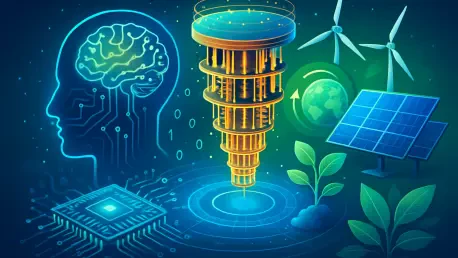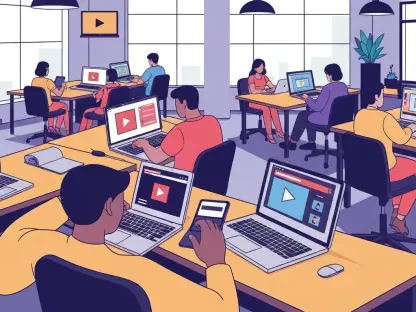As the technological landscape evolves at a breathtaking pace in 2025, a wave of transformative innovations is redefining how industries operate, economies grow, and societies function on a daily basis. Artificial Intelligence (AI) has emerged as a central force, no longer just a tool but a driver of autonomous decision-making that reshapes everything from healthcare to logistics. Quantum computing, though still maturing, promises to unlock solutions to problems once deemed unsolvable, while sustainability has become a non-negotiable focus, pushing tech to align with environmental imperatives. Beyond these, advancements in connectivity through 5G and the Internet of Things (IoT), alongside robust cybersecurity needs and the vibrant energy of startups, paint a picture of a world where innovation must balance with responsibility. This exploration delves into these pivotal trends, unpacking their potential to revolutionize the present while highlighting the challenges that demand careful navigation for a balanced and impactful future.
AI as a Strategic Powerhouse
The ascent of AI in 2025 marks it as a cornerstone of strategic operations across diverse sectors, fundamentally altering how challenges are approached and solutions are crafted. Far beyond simple automation, AI now embodies agentic systems capable of independent decision-making, leveraging real-time data to enhance outcomes in fields like medical diagnostics and financial forecasting. This capability allows for unprecedented efficiency, enabling hospitals to predict patient needs with precision or businesses to optimize supply chains dynamically. However, this rapid integration brings forth critical ethical dilemmas, such as ensuring transparency in automated decisions and preventing biases embedded in algorithms. The balance between harnessing AI’s potential and maintaining rigorous oversight is a pressing concern, as unchecked systems could lead to unintended consequences that ripple through society. Addressing these issues requires not just technological innovation but also a commitment to developing frameworks that prioritize accountability at every step.
Another dimension of AI’s transformative role lies in its synergy with other technologies, amplifying its impact on both operational and societal levels in 2025. When paired with IoT, AI can process vast streams of data from connected devices to enable smarter urban planning or predictive maintenance in industrial settings. This interconnectedness, while powerful, also heightens vulnerabilities, as the sheer volume of data opens new avenues for breaches if not safeguarded properly. Moreover, the adoption of AI-driven solutions is reshaping workforce dynamics, with automation potentially displacing routine roles while creating demand for skilled oversight and ethical management. Industries must adapt by investing in reskilling programs to prepare employees for this shift, ensuring that technological progress does not widen socioeconomic gaps. The challenge is to integrate AI in a way that fosters inclusivity, balancing innovation with the human element to create systems that serve rather than dominate the fabric of daily life.
Quantum Computing’s Emerging Potential
Quantum computing stands at the threshold of revolution in 2025, offering a glimpse into a realm where complex problems once thought impossible to solve become manageable through unparalleled processing power. Unlike traditional computers, quantum systems leverage principles of superposition and entanglement to perform calculations at speeds that could transform fields such as drug discovery, where simulating molecular interactions could drastically shorten development timelines. Climate modeling also benefits, as quantum algorithms help predict environmental changes with greater accuracy, aiding in strategic planning. Yet, despite these promising applications, the technology remains in a nascent stage, with significant technical barriers limiting widespread adoption. The infrastructure required to maintain quantum states is intricate and costly, posing a challenge to scaling this innovation across industries eager to tap into its potential for groundbreaking solutions.
Beyond the technical hurdles, quantum computing in 2025 faces a critical intersection with broader societal and environmental goals that cannot be overlooked. One major concern is the immense energy consumption associated with quantum systems, which often require extreme cooling to operate effectively, raising questions about their alignment with sustainability objectives. As industries push for greener practices, the energy demands of quantum tech could counteract progress if not addressed through innovative power solutions or hybrid approaches. Additionally, the specialized nature of quantum applications means that access is likely limited to well-funded entities, risking a disparity in who benefits from these advancements. To mitigate this, collaborative efforts between governments, academia, and private sectors are essential to democratize access and ensure that quantum breakthroughs contribute to global challenges equitably, rather than deepening existing divides in technological capability.
Sustainability Driving Tech Innovation
Sustainability has transcended being a mere trend in 2025, embedding itself as a core principle that shapes the direction of technological advancement with both moral and economic weight. Innovations such as bio-based materials for manufacturing and decentralized renewable energy grids are gaining momentum, reflecting a shift toward solutions that reduce environmental impact while maintaining efficiency. Companies adopting these green technologies often see a dual benefit—enhanced public perception and tangible revenue growth as consumers increasingly favor eco-conscious brands. This drive is evident in sectors ranging from transportation to construction, where sustainable practices are no longer optional but a competitive necessity. However, the transition to such infrastructure demands substantial investment, and without supportive policies or incentives, smaller enterprises risk being left behind in this critical shift toward a greener technological ecosystem.
The challenges of integrating sustainability into tech innovation in 2025 reveal a complex landscape where economic realities often clash with environmental aspirations. High upfront costs for adopting green systems, such as retrofitting factories with energy-efficient equipment or developing carbon-neutral supply chains, can deter widespread implementation, particularly in regions with limited financial resources. Additionally, the lack of universal regulatory frameworks creates inconsistencies, as some areas enforce strict environmental standards while others lag, leading to uneven progress. Despite these obstacles, the push for sustainability is fostering collaboration across industries, encouraging the development of scalable solutions like nanotechnology for waste reduction. The key lies in aligning technological advancements with long-term ecological goals, ensuring that innovation serves as a catalyst for preserving resources rather than depleting them, and setting a precedent for responsible growth in the years ahead.
Connectivity and Cybersecurity Challenges
The rapid expansion of 5G networks and IoT in 2025 is laying the foundation for a hyper-connected world, enabling real-time applications that transform urban environments into smart cities and enhance global communication. This connectivity empowers everything from autonomous vehicles navigating traffic with precision to remote healthcare systems delivering care across borders through multilingual AI interfaces. The potential for seamless integration into daily life is immense, promising efficiency and accessibility on a scale previously unimaginable. Yet, this interconnectedness also amplifies disparities, as regions with limited access to high-speed networks risk falling further behind in the digital divide. Addressing this requires targeted policies that prioritize infrastructure development in underserved areas, ensuring that the benefits of advanced connectivity are not confined to privileged zones but contribute to a more inclusive technological landscape.
Alongside connectivity, the escalating importance of cybersecurity in 2025 cannot be overstated, as the proliferation of AI, IoT, and immersive technologies like augmented reality introduces new vulnerabilities that threaten data integrity. AI-driven cyber threats, capable of adapting to defenses in real time, pose a significant risk, while the vast data generated by connected devices creates multiple entry points for breaches. Protecting against these dangers demands sophisticated strategies, such as AI-powered defense mechanisms and hybrid cloud systems that distribute data securely. The stakes are high, as failures in cybersecurity could undermine trust in emerging technologies, stalling progress. Meanwhile, the startup ecosystem adds another layer of complexity, with venture capital fueling innovative security solutions but also intensifying competition, occasionally leading to overhyped promises. A balanced approach, focusing on robust governance and sustainable investment, is crucial to safeguarding this interconnected future.
Balancing Innovation with Responsibility
Reflecting on the technological strides made in 2025, it becomes evident that AI has solidified its role as a transformative force, quantum computing has begun to carve out niche yet powerful applications, and sustainability has emerged as a guiding principle for innovation. The expansion of 5G and IoT has reshaped connectivity, while cybersecurity has proven indispensable in protecting against evolving threats. Startups and investments have injected vitality into the tech space, driving forward-thinking solutions even as they navigate competitive pressures. Each of these elements has contributed to a dynamic landscape, where the promise of progress is matched by the weight of responsibility to address ethical, environmental, and social challenges.
Looking ahead, the focus must shift to actionable strategies that ensure these advancements yield equitable benefits over the coming years from 2025 onward. Policymakers and industry leaders should prioritize frameworks that integrate ethical guidelines into AI deployment, invest in energy-efficient quantum systems, and incentivize green tech adoption through subsidies. Bridging the digital divide through inclusive 5G rollout and fostering cybersecurity innovation via public-private partnerships are also vital steps. By embracing these measures, the tech industry can build on past achievements to create a future where innovation serves as a unifying force, addressing global challenges with a commitment to accountability and shared progress.









